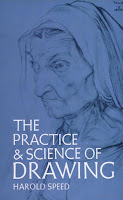 On the GJ Book Club, we're looking at Chapter 20: "Materials" in Harold Speed's 1917 classic The Practice and Science of Drawing.
On the GJ Book Club, we're looking at Chapter 20: "Materials" in Harold Speed's 1917 classic The Practice and Science of Drawing.In this chapter, Speed talks about a wide range of drawing media and the capabilities that each one offers. I'll outline the main points of the chapter so that you can refer to them in the comments if you want.
1. Speed advises trying all kinds of drawing media out to explore their range of expressive possibilities. Then, he suggests that we should seek those qualities of the subject that are suited to the capacities of the medium.
 |
| Rembrandt, ink and wash drawing |
This same sort of argument has recently been applied to the realistic potential of CG animation. The idea is that the ultra-realistic computer simulations can take away from the capacity that the animation medium has to create stylized shape and movement, which can have more psychological and emotional resonance. The unquestioning pursuit of imitation of nature can blind an artist to the conscious choices that an artist must make.
I only partially agree with Speed on this point. As much as I love stylization and caricature, I also believe that extreme realism is anything but a "meretricious deception," and achieving it is not easy, especially not in paint. Even if one's goal were to hold up a perfect mirror to nature in oil paint or digital animation, that would only be possible with a sophisticated awareness of the limitations of even those tools. And ultra-realism is capable of conveying subjective emotions, depending on the spirit and skill of the artist.

3. Central to Speed’s argument is that every art medium has a limitation, whether it be stop motion animation, black and white film, charcoal pencils, pen and ink, or sanguine. Great masters, he says, “represent nature in terms of whatever medium they worked in, and never overstepped this limitation."
4. I do agree with Speed that students are well advised to approach oil painting with self-imposed limitations, such as monochrome or a limited palette. Such limitations are liberating.
5. Then, Speed lists each of the drawing media: lead pencil, silverpoint, charcoal, red chalk (sanguine), black Conté, white chalk, lithography, pen and ink, and paper. Reading his descriptions of each of them was inspiring to me, as I haven't tried several of them, such as silverpoint and lithography.
In the comments I'd love to hear from people who have tried some of the less common materials that he refers to, and I wonder how your experience tallies with his.
In the comments I'd love to hear from people who have tried some of the less common materials that he refers to, and I wonder how your experience tallies with his.
------
The Practice and Science of Drawing is available in various formats:
1. Inexpensive softcover edition from Dover, (by far the majority of you are reading it in this format)
2. Fully illustrated and formatted for Kindle.
3. Free online Archive.org edition.
4. Project Gutenberg version
Articles on Harold Speed in the Studio Magazine The Studio, Volume 15, "The Work of Harold Speed" by A. L. Baldry. (XV. No. 69. — December, 1898.) page 151.
and The Windsor Magazine, Volume 25, "The Art of Mr. Harold Speed" by Austin Chester, page 335. (thanks, अर्जुन)
1. Inexpensive softcover edition from Dover, (by far the majority of you are reading it in this format)
2. Fully illustrated and formatted for Kindle.
3. Free online Archive.org edition.
4. Project Gutenberg version
Articles on Harold Speed in the Studio Magazine The Studio, Volume 15, "The Work of Harold Speed" by A. L. Baldry. (XV. No. 69. — December, 1898.) page 151.
and The Windsor Magazine, Volume 25, "The Art of Mr. Harold Speed" by Austin Chester, page 335. (thanks, अर्जुन)
GJ Book Club on Pinterest (Thanks, Carolyn Kasper)
GJ Facebook page
Overview of the blog series
Announcing the GJ Book Club
Chapter 1: Preface and Introduction
Chapter 2: Drawing
Chapter 3: Vision
Chapter 4: Line Drawing
Chapter 5: Mass Drawing
Chapter 6: Academic and Conventional
Chapter 7: The Study of Drawing
Chapter 8: Line Drawing, Practical
Chapter 9: Mass Drawing
Chapter 10: Rhythm
Chapter 11: Variety of Lines
Chapter 12: Curved Lines
Chapter 13: Variety of Mass
Chapter 14: Unity of Mass
Chapter 15: Balance
Chapter 16: Proportion
Chapter 17: Portrait Drawing
Chapter 18: Visual Memory
Chapter 19: Procedure
Chapter 20: Materials


I've recently gotten back into oil painting after a long time away, and it's made all the difference to work with limited palettes, color gamuts, and other self-imposed "handicaps." When I was young and learning I was so determined to get a "good picture" - which at the time meant something that looked like the real thing - I never stopped to think about making a piece of artwork as well. After spending five or six years working digitally, now I'm just reveling in all the feels and textures and the beauty and wonder (and happy accidents) of mixing colors and values and putting them down with a brush. It's become so much more about the process of making art and less about the end result - probably a good thing, at least in moderation!
ReplyDeleteI haven't been able to keep up reading Speed's book but sure have appreciated these weekly summaries.
When I was in school, we did a class where we drew in silver point. it's pretty easy, just get a small wire, use a nail fixed to a drill to make a hole in a pencil shaped piece of wood. drop the wire in and fasten it. maybe with epoxy. It gets intensely detailed pretty fast and is pretty mesmerizing, like the first time using a mechanical pencil...
ReplyDeleteThis comment has been removed by the author.
ReplyDeleteThis comment has been removed by the author.
ReplyDeleteThis comment has been removed by a blog administrator.
ReplyDeleteI assumed he was speaking of Trompe L'oeil works in particular.
ReplyDeleteWell, in that case; nevermind then.
ReplyDelete#2. I'm actually on the fence about this. As I've read this book and reflected on those works I've seen that fell into both camps, I've thought a lot about the idea of art being expression verses capturing exactly what one sees or experiences, and while there's no denying the ability and mastery of a medium in an exact representation I find the expressive works more enjoyable and intriguing. I remember seeing the Chuck Close exhibit in NYC almost 20 years ago and being in awe of the sheer size at which he painted exact replicas of what he saw in his earlier work, but his work didn't have the same effect or lasting impression as more expressive works that to me better capture the experiences, POV or feelings of the artist, and yet a beautiful photograph can closely approximate the expressive nature of less-than-exact art. Why? The medium and expectation/appreciation of what's necessary for each mostly. Rarely do I enjoy an abstract photograph much the same way as I don't a realistic painting and yet are they any less art?
ReplyDeleteI'm no more qualified to answer this than to paint one or the other, but the more I think about what I want to accomplish my own work, the more I find myself leaning towards Speed's sentiment.